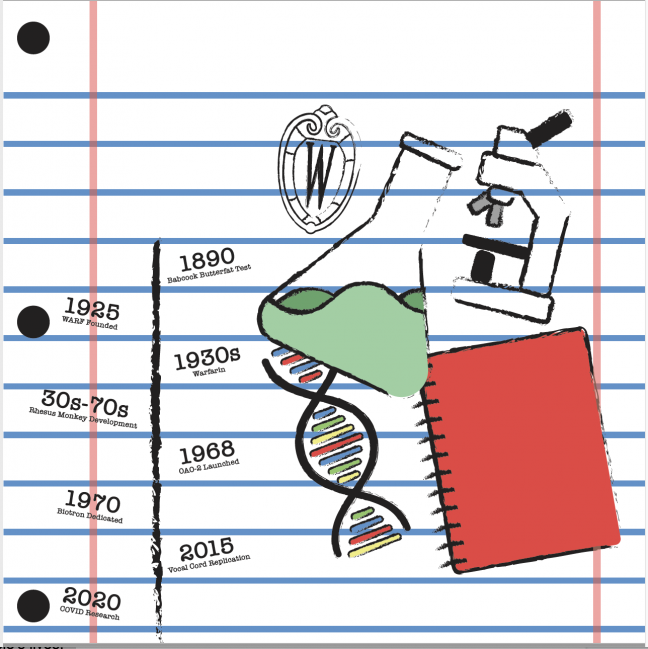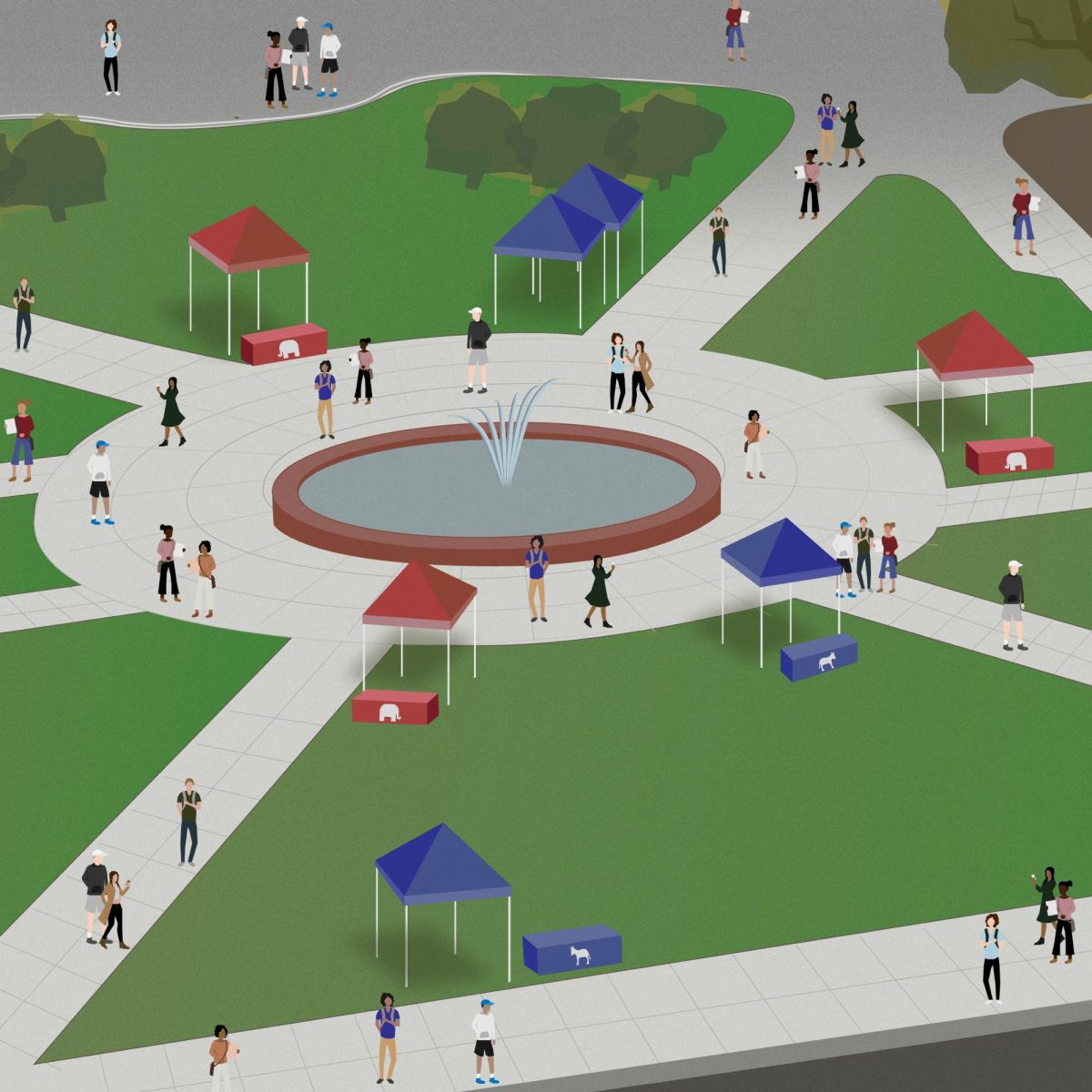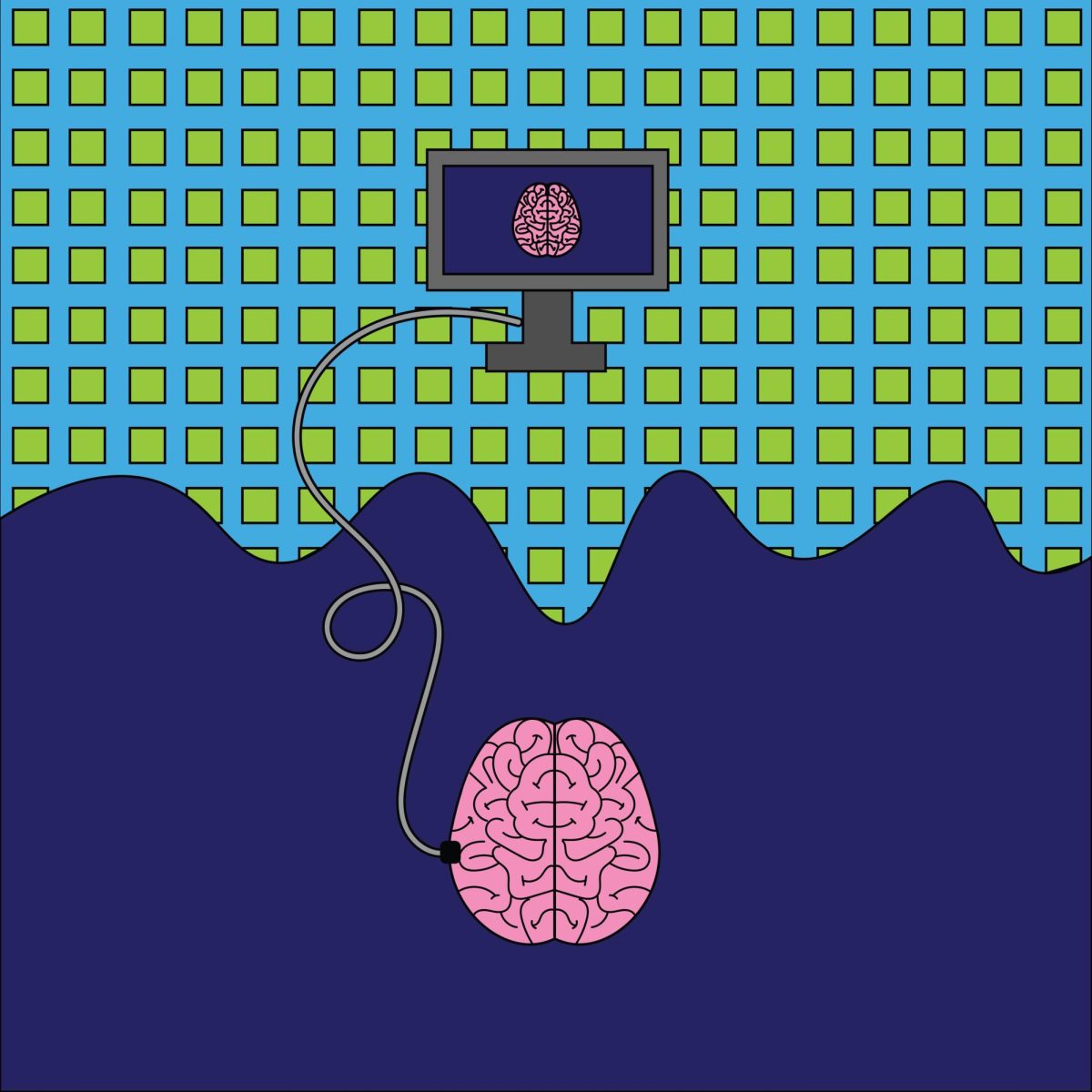The beginning of a legacy
The Babcock name is renowned among Union dwellers and ice cream enthusiasts, but far beyond frozen treats, Stephen Babcock represents the start of an enduring tradition of scientific innovation at the University of Wisconsin.
In 1890, Babcock, an agricultural chemist at UW, developed the Babcock butterfat test. This test, which measures the fat content of milk, allowed the dairy industry to differentiate prices based on quality, incentivizing farmers to invest in improvements of their product.
In addition to revolutionizing the dairy industry, Babcock’s test set a precedent for UW researchers to be at the forefront of their fields and translate scientific discoveries into improvement of people’s lives.
Every major breakthrough at UW built off of previous research, and without that collaboration, some of the scientific world’s most significant developments would never have been realized. From the fundamental discovery of vitamins, to collecting images in outer space, and even to the pressing issues of COVID-19 research today, UW has been involved in every facet of the developments which are still affecting our lives today.
Vital vitamins
It was 1907 when E.V. McCollum joined the UW agricultural chemistry department. While working on a nutrition experiment designed by Babcock, he observed stark differences in the appearance and physiology of cows fed different diets. McCollum became driven to discover the unknown factor he hypothesized was causing discrepancies.
McCollum’s unconventional rat-based experiments were only tolerated by the university due to Babcock’s approval of the project, but they yielded tremendous results. Working with graduate Marguerite Davis, McCollum’s studies resulted in the discovery of a fat-soluble nutrient, which would later be named vitamin A. McCollum and Davis also discovered the presence of a water-soluble nutrient, called vitamin B.
Professor Harry Steenbock, a former lab assistant of McCollum, continued UW’s legacy of groundbreaking biochemical nutrition-related research through the 1920s. Steenbock was the first to determine increased sunlight led to calcium retention. He discovered shining food with UV light had the same effect.
Through McCollum’s work, society was introduced to the idea of vitamins and the importance of a balanced diet — Steenbock took this research one step further. Through patenting and implementing his irradiation technique, Steenbock effectively eradicated rickets, a disease in children caused by a vitamin D deficiency that softened and distorted bones, as a widespread disease.
In the process of independently patenting his methods and receiving commercial offers for their use, Steenbock saw the need for a separate entity to manage patents of UW’s novel products and use the revenue to fund future research. In 1925, the Wisconsin Alumni Research Foundation was founded.
Building a network
WARF was the world’s first technology transfer office, a center now common among universities, which helps take research developments and transfer them into the commercial marketplace. WARF aims to transfer ideas born on campus out into the world, said Kevin Walters, the public affairs analyst for WARF.
“WARF’s goal is to transfer ideas created on campus out into the world,” Walters said. “We want to be on the forefront of adapting, especially in such an uncertain time. With great challenges come great opportunities.”
With catastrophically low share prices, the stock market crash of the 1930s was the ideal time to build an investment portfolio based on the royalties from Steenbock’s patents, Walters said.
“The key to WARF’s funding is our investment portfolio,” Walters said. “With that we are able to give a consistent grant each year regardless of how much in royalties comes in.”
Today, that portfolio has grown to $3.2 billion in funds, and over three billion dollars of grants have been awarded to UW through WARF.
WARF’s largest investment to date came from biochemistry professor and former student of Steenbock himself — Hector DeLuca. As the last graduate student to study under Steenbock, DeLuca recalled in an interview with The Badger Herald being very excited to receive an assistantship with him. DeLuca said Steenbock’s work to enrich foods with vitamin D was legendary.
DeLuca arrived at UW in 1951 when he began his graduate studies. In that time, he developed nearly 2,000 patents for use of primarily vitamin D derivatives to treat various diseases.
DeLuca’s research provided therapies for osteoporosis, multiple sclerosis, rheumatoid arthritis and organ transplant rejection.
Walters said DeLuca’s invention Zemplar, an active form of vitamin D which is used to treat hormonal imbalance in patients with kidney failure, was WARF’s largest investment. With three buildings named after him and a lifetime of dedicated work, DeLuca’s impact on UW research and campus can hardly be limited to any one development.
“There are so many aspects to which I’m very grateful I came here,” DeLuca said of his time at UW. “I couldn’t have chosen a better place to come or person to work with.”
UW and the Space Age
One of WARF’s most vital scientific contributions on campus benefitted a very different field of research — astronomy. Astronomy Professor Jim Lattis said UW built Pine Bluff Observatory in the midst of the 1950s to serve as a new site for research with more modern capabilities than the historic Washburn observatory, built in 1881. Pine Bluff was home to a plethora of key research developments and housed equipment for both the astronomy and physics departments.
In the field of astronomy, UW’s most significant involvement was the Orbiting Astronomical Observatory 2. Launched in 1968, OAO-2 was in orbit for four years, during which time it helped collect data regarding a broad range of topics in space. Lattis said OAO-2 had two central contributors, the Smithsonian museums and UW. Researchers at UW spent decades developing photoelectric photometry instruments that could be adapted to use in space. Before their discovery, the only option available to collect images was photography.
“OAO-2 was in a lot of ways the culmination of years of astronomical development,” Lattis said. “It was one of the reasons we were ever able to run the Hubble telescope, and it showed the possibility of operating an observatory in space.”
The method of photometry was groundbreaking, as UW was one of the only locations studying the discipline at the time, Lattis said. UW’s success with the instruments in OAO-2 would lead them to develop some of the original instruments for the Hubble telescope, which were also specialized photometry instruments.
Lattis said space research slowed since these 20th century projects, but UW is still involved in several telescope operations and many astrophysical research projects.
”I think learning about astronomy is fundamental to answering some of these philosophical questions in life, like who are we and what is our place in the universe?” Lattis said. “One has to keep engaging in these things to keep a healthy society.”
Lattis attributed the success of astronomy research during the Space Age to UW’s willingness to take risks and fund novel projects. Lattis said the school’s generally supportive attitude encourages researchers to pursue their interests.
The Biotron was another large investment in research advancement made by the university. The Biotron would prove to have immense payoffs and become a historic lab at UW. Dedicated in 1970, the Biotron allows researchers to recreate any terrestrial environment on earth by controlling temperature, lighting, humidity and plant-watering schedules.
The Biotron’s unique capabilities allowed it to host several monumental research projects. In the realm of space research, NASA tested the Galileo probe at the Biotron before its launch. Food was first grown by LED lights in the Biotron in 1986. In the following months, astronauts in space used the same technique to grow their own food in space.
The chamber was also used to test products like Arctic drilling equipment and insulin pumps. Even the Babcock Dairy Store’s cheese has been put to the test within the Biotron’s walls.
After 50 years of housing research, the Biotron ended its role as a campus center March 31, 2021, however, its legacy and contributions to UW research will continue to be felt on campus for decades to come.
Medicinal breakthroughs
It is virtually impossible to mention research legacies at UW and not include a key medical development — Warfarin. In 1933, School of Agriculture professor Karl Paul Link met with a distressed farmer whose livestock were inexplicably dying. After eight years of researching, Link was able to isolate a blood-thinning agent from the cow’s feed that was determined to be the cause of death.
The agent was patented by and named after WARF, and warfarin became one of the most widely prescribed blood thinners in the world. Today, warfarin is used to treat or prevent strokes, heart attacks or other blood clotting issues.
Another major medical innovation which emerged from UW was a surgical technique to remove skin cancer developed in the 1930s by Dr. Frederic Mohs. Mohs’ research, funded in part by WARF grants, led him to realize the value of using microscopy to treat skin cancer in order to ensure that cancerous cells not visible to the naked eye are removed.
Dr. Juliet Alyward of UW Health is an expert on Mohs surgery and has performed the procedure over 17,000 times. In 60% to 70% of skin cancer cases, Alyward said the spread of cancer cells is often much larger than the tumor that is immediately visible. Therefore, Alyward said a method beyond merely observing a tumor with the naked eye proves invaluable.
The procedure involves removing skin cancer using local anesthetic, then analyzing the removed tissue under a microscope. Multiple tissue removals can occur until the analysis shows the cancerous cells completely surrounded by healthy tissues, indicating the cancer has been entirely removed.
Mohs surgery continues to be a relevant practice for over almost 90 years, an impressive feat in a field as rapidly evolving as medicine. Alyward credits a remarkably high cure rate of 99% and high patient safety as factors for its endurance.
Monkeys and studying the mind
Harry Harlow conducted psychology research with rhesus monkeys from the 1930s to the 1970s, and his work, while controversial, is widely recognized to have changed society’s understanding of mammalian development, especially regarding infant-mother relationships. Some of his most famous studies involved raising infant monkeys with either a wire or cloth “mother,” or completely socially isolating them in dark, sterile environments.
As a result of Harlow’s experiments, psychologists gained pivotal insights into human behavior — the obvious detriment of being socially deprived demonstrates the value of social contact for emotional growth. Despite these outcomes, the studies have been heavily criticized for the developmental harm that resulted in the isolated monkeys.
Harlow — alongside his wife and fellow psychologist Margaret Harlow — helped to change the face of parenting to a more engaged, contact-heavy experience. Primate center outreach specialist, Jordana Lenon, said parenting was a hands-off endeavor, with parents setting children up with nannies instead, up until the 1950s.
“Part of their legacy is that parents today are much more involved with their babies from birth, Lenon said. “Frequently holding them, touching them, staying close by. Even babies smelling their parents, when combined with touch, promotes healthy brain development.”
Harry Harlow was also the first director of the Wisconsin National Primate Research Center, then named the Wisconsin Regional Primate Center. He effectively founded primate research at UW, which grew to be one of the most influential research centers on campus.
The primate center facilitated major research breakthroughs, especially in the areas of stem cells and HIV treatments.
James Thomson was the head veterinary pathologist at the WNPRC in 1995, when he became the first in the world to successfully isolate and culture stem cells from a rhesus monkey embryo. Three years later he replicated the feat in a human embryo and made national headlines for the new field of research he had just unlocked. Since his discovery, multiple projects entered human clinical trials investigating treatments of diseases such as macular degeneration and Parkinson’s.
One particular study from March of 2021 using rhesus monkeys showed implanting neurons developed from the monkey’s own cells helped alleviate symptoms of Parkinson’s disease by about 40%. Researchers are hopeful that after extensive clinical trials that are yet to be conducted, a similar process could potentially act as a Parkinson’s treatment in human patients.
In the realm of HIV research, the WNPRC helped develop life-saving medications, new vaccine possibilities and gel designed to prevent HIV transmission from mothers to their newborns. Most recently, a study involving gene editing to prevent reception of the virus by the body’s cells suggested a treatment for HIV may be on the horizon.
Genes and vaccines: UW in the age of COVID-19 research
Early genetics work conducted at UW includes Howard Temin’s revolutionary discovery of reverse transcriptase in 1975, which earned him the Nobel Prize and was essential for understanding how retroviruses such as HIV hijack healthy cells. Without this understanding, the WNPRC’s treatment research could not exist, because there would not be enough known about the virus’ mechanisms to intervene with them.
Prior to Temin’s work, Har Gobind Khorana uncovered the way in which genetic codes translate into amino acids in the 1960s. His discovery eventually led him to earn a Nobel Prize after he became the first known researcher to synthesize a gene. Both Khorana and Temin’s discoveries would prove to be vital in addressing the medical world’s most recent dilemma — COVID-19.
Temin’s and Khorana’s work with genetics paved the way for future researchers like Jon Wolff to work on delivering DNA or RNA into muscle cells. One of Wolff’s most influential papers demonstrated that delivery of DNA or RNA into muscle could lead to the expression of proteins. This technology was part of the foundation in which the mRNA vaccines against SARS-CoV-2 were based.
Two of UW’s own virologists, Yoshihiro Kawaoka and Gabriele Neumann, applied Wolff’s work and developed a nasally-delivered COVID-19 vaccine that is currently in human trials. The technology regarding the vaccine was patented through WARF and involves genetic modification which likely wouldn’t have been possible without the work of the UW researchers.
The WNPRC is currently working on COVID-19-related research as well. Lenon said the center built a coalition of scientists to help fight COVID-19. Working with the National Institute of Health, the coalition used primate models to study virus resistance, transmission routes and organs the virus attacks. Renovations are also set to begin soon to construct a new UW Animal Bio-Safety Level 3 lab that will allow researchers to study COVID-19 vaccines, treatments and transmission in a setting that cannot be safely done in a lower ABSL facility.
Lenon said WNPRC plans to continue researching pressing issues regarding COVID-19 including novel variants, and the mysterious “long COVID-19,” which involves patients experiencing prolonged symptoms of the virus months after testing positive.
Looking to the future
Lenon said the WNPRC’s research efforts have been a collaboration with centers across campus and even other institutions.
“Nothing’s done in a vacuum,” Lenon said. “Scientists from different areas and different disciplines collaborate to find new ways to treat and cure diseases, and I think that’s amazing. What people don’t always think about is that science takes time. Even all of the COVID-19 research that appeared to progress at lightning speed was based on decades of studying.”
The same can be said for most breakthroughs at UW. Behind every new scientific discovery is a history of prior work — each development building off of the next. Without Babcock’s encouragement, McCollum would not have had access to the mechanism to discover vitamin A, and without Temin and Khorana’s genetics work, the vaccines that now represent a solution to a global pandemic may not exist.
Even now there is an abundance of UW research in progress that elaborates on the discoveries of the past. DeLuca is continuing UW’s renowned vitamin research, which may well be used to treat even more diseases in the future. Mohs surgery will likely continue to modernize, as Alyward listed multiple advancements in the works that would allow for even more precise removal of cancer cells. There is even an entire center dedicated to the stem cell research that was made possible by Thomson’s work with the WNPRC, which has found possible treatments for burn injuries, blood disease and even blindness. These projects and many more currently in progress are taking past discoveries and translating that knowledge to the improvement of people’s lives.
With hundreds of projects in progress and WARF’s consistent grant firmly in place, UW’s research future looks promising, as it is a future built on a foundation of over a century of discovery.








